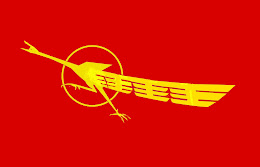Breaking News: ဒီေန႔ ရရွိေသာေနာက္ဆုံးသတင္း အရ အေမရိကန္ၿပည္ေထာင္စုအစုိးရက ေဒၚလာ ၈၅ ဘီလီယံ ကုိ ေအအုိင္ဂ်ီ( AIG) ကုမၸဏီအား ေငြေခ်းကူညီဖုိ႔ဆုံးၿဖတ္လုိက္ပါၿပီ။
 အေမရိကန္ႏိုင္ငံ၏ သက္တမ္း(၁၅၈)ႏွစ္ရွိၿပီျဖစ္ေသာ အထင္ကရ ရင္းႏွီးျမဳပ္ႏွံမႈ ဘဏ္လုပ္ငန္းစုႀကီးတစ္ခုျဖစ္ေသာ ေလးမန္းညီအစ္ကိုမ်ား (Lehman Brothers)ကုမၸဏီသည္ Credit Card အရႈပ္အေထြးမ်ား ေပၚေပါက္ၿပီးေနာက္ ရွယ္ယာတန္ဖိုးမ်ားထိုးက်ကာ ၿပိဳကြဲပ်က္စီးေတာ့မည့္ အေျခအေနႏွင့္ ႀကံဳေတြ႕ေနရၿပီျဖစ္သည္။ အေမရိကန္၏ ကုန္သြယ္မႈ ဗဟိုေနရာႀကီးျဖစ္သည့္Wall Streetတြင္လည္း ေလးမန္းညီအစ္ကိုမ်ား ကုမၸဏီအရႈပ္အေထြးေၾကာင့္ ဂရက္ရိုက္ခတ္မႈမ်ားရွိေနသည္ဟုဆိုသည္။ Wall Streetမွ ဝန္ထမ္း (၄၀,၀၀၀)ခန္႕ကုိ ေလွ်ာ့ခ်သြားဖြယ္႐ွိသည္။
အေမရိကန္ႏိုင္ငံ၏ သက္တမ္း(၁၅၈)ႏွစ္ရွိၿပီျဖစ္ေသာ အထင္ကရ ရင္းႏွီးျမဳပ္ႏွံမႈ ဘဏ္လုပ္ငန္းစုႀကီးတစ္ခုျဖစ္ေသာ ေလးမန္းညီအစ္ကိုမ်ား (Lehman Brothers)ကုမၸဏီသည္ Credit Card အရႈပ္အေထြးမ်ား ေပၚေပါက္ၿပီးေနာက္ ရွယ္ယာတန္ဖိုးမ်ားထိုးက်ကာ ၿပိဳကြဲပ်က္စီးေတာ့မည့္ အေျခအေနႏွင့္ ႀကံဳေတြ႕ေနရၿပီျဖစ္သည္။ အေမရိကန္၏ ကုန္သြယ္မႈ ဗဟိုေနရာႀကီးျဖစ္သည့္Wall Streetတြင္လည္း ေလးမန္းညီအစ္ကိုမ်ား ကုမၸဏီအရႈပ္အေထြးေၾကာင့္ ဂရက္ရိုက္ခတ္မႈမ်ားရွိေနသည္ဟုဆိုသည္။ Wall Streetမွ ဝန္ထမ္း (၄၀,၀၀၀)ခန္႕ကုိ ေလွ်ာ့ခ်သြားဖြယ္႐ွိသည္။
(Wall Street လုပ္ငန္းခြင္)

(AIG အုပ္စုအေဆာက္အဦး)
ကမာၻေပၚတြင္ အႀကီးဆံုးဘဏ္လုပ္ငန္းစုႀကီးတစ္ခုျဖစ္ေသာ ေလးမန္းညီအစ္ကိုမ်ား အုပ္ခ်ဳပ္မႈပိုင္းမွမူ ေငြေၾကးဆိုင္ရာပုဒ္မ(၁၁)ႏွင့္ ၿငိစြန္းမႈမရွိေစရန္ ကုမၸဏီ၏အေရးပါေသာ ကုန္သြယ္မႈယူနစ္မ်ားကို ေရာင္းခ်သြားမည္ဟု စက္တင္ဘာလ(၁၅)ရက္ေန႔က ေၾကညာခဲ့သည္။ ေလးမန္းညီအစ္ကိုမ်ားကုမၸဏီ၏ ေငြေၾကးအရႈပ္ေတာ္ပံုမွာ ဥပေဒေၾကာင္းႏွင့္ပါဆက္ႏြယ္လာၿပီး အစိုးရမွကိုင္တြင္သြားမည္ဟု တရားသူႀကီး ဂ်ိမ္းပက္ခ္စ္က သတင္းေထာက္မ်ားကိုေၾကညာခဲ့သည္။ နယူးေယာ့ခ္ၿမိဳ႕ေတာ္ ေတာင္ပိုင္းရွိတရားရံုးတစ္ခုတြင္ ကုမၸဏီအမႈအခင္းအား ၾကားနာစစ္ေဆးသြားမည္ျဖစ္ၿပီး ေလးမန္းကုမၸဏီသည္ ေျမယာႏွင့္Credit Cardမ်ားကိစၥတြင္ အရံႈးေပၚေနမႈေၾကာင့္ ေဒၚလာ(၆၀)ဘီလ်ံမွ် လိုေငြျပေနသည္ဟု ေဖာ္ျပထားသည္။ ေလးမန္းကုမၸဏီသည္ ယမန္ႏွစ္ကတည္းက ကမာၻအရပ္ရပ္ရွိ ဘဏ္မ်ားႏွင့္ဆက္သြယ္ကာ ေျမယာအေရာင္းအ၀ယ္မ်ားတြင္ ရင္းႏွီးျမွဳပ္ႏွံမႈမ်ား ေဒၚလာဘီလ်ံ(၃၀၀)ဖိုးခန္႔ ထည့္၀င္လုပ္ကိုင္ခဲ့ၿပီး ယခုကဲ့သို႔လားမန္းကုမၸဏီက်ဆံုးမႈမွာWall Street၏ ခိုင္မာမႈကိုပင္ ယိမ္းယိုင္ထိခိုက္သြားေစေၾကာင္း အေမရိကန္မွ စီးပြားေရးပါရဂူမ်ားက သံုးသပ္ေျပာဆိုခဲ့သည္။

(Lehman Brothers MD သတင္းေထာက္မ်ားႏွင့္ေတြ႕ဆုံရန္ ႐ုံးခန္းမွထြက္လာစဥ္)

(Lehman Brothersမွ ထြက္ခြာလာေသာ ဝန္ထမ္းတစ္ဦး)
ေလးမန္းညီအစ္ကိုမ်ားကုမၸဏီကို(၁၈၄၄)ခုႏွစ္က ဟင္နရီေလးမန္းဆိုသူက ဂ်ာမနီႏိုင္ငံ ရင္ပါအရပ္တြင္စတင္တည္ေထာင္ခဲ့ၿပီး ေနာက္ပိုင္းတြင္အေမရိကန္သို႔ ေျပာင္းေရႊ႕အေျခစိုက္ခဲ့ၿပီး ကမာၻေပၚတြင္ အႀကီးက်ယ္ဆံုးဘဏ္လုပ္ငန္းစုႀကီး ျဖစ္လာခဲ့သည္။ ေလးမန္း၏ေငြေၾကးအရႈပ္အေထြးသတင္းမ်ားေပၚေပါက္လာအၿပီး လားမန္းဘဏ္လုပ္ငန္းစု၏ ေဖာက္သည္မ်ားစြာတို႔သည္ ေလးမန္းကုမၸဏီရံုးခ်ဳပ္ေရွ႕သို႔ စုရံုးခဲ့ၾကေၾကာင္း မ်က္ျမင္မ်ားကေျပာၾကားခဲ့သည္။ အေမရိကန္ႏိုင္ငံ ေငြေၾကးလံုၿခံဳမႈႏွင့္လဲလွယ္မႈဗဟိုဌာနက ေလးမန္းကုမၸဏီအရႈပ္အေထြးေၾကာင့္ ၎ႏွင့္ဆက္သြယ္လုပ္ကိုင္ေနေသာ နာမည္ေက်ာ္ ရင္းႏွီးျမဳပ္ႏွံမႈအုပ္စု AIGကဲ့သုိ႕ အျခားစီးပြားေရးလုပ္ငန္းမ်ားစြာသို႔လည္း ထိခိုက္မႈရွိမည္ဟု မွတ္ခ်က္ျပဳသြားသည္။ ေလးမန္းကုမၸဏီကမူ ထိုအေျခအေနအား ေျဖရွင္းႏိုင္ရန္ ႀကိဳးစားေနေၾကာင္းေၾကျငာခဲ့ၿပီး ထိုေၾကျငာခ်က္တြင္ ေမလ(၃၁)ရက္ေန႔ထိ စာရင္းမ်ားအရ ဘဏ္လက္က်န္ေငြအျဖစ္ ေဒၚလာ(၆၃၉)ဘီလ်ံရွိေနေသးၿပီး (၆၁၃)ဘီလ်ံမွ်အေၾကြးတင္ေနေၾကာင္း ထည့္သြင္းေဖာ္ျပထားသည္။ ေလးမန္းကုမၸဏီဂယက္ေၾကာင့္ အာ႐ွႏုိင္ငံမ်ားျဖစ္သည့္ ထုိင္ဝမ္၊ ဂ်ပန္စသည့္ႏုိင္ငံမ်ားတြင္လည္း စေတာ့႐ွယ္ယာေစ်းမ်ား က်ဆင္းလ်က္႐ွိသည္။
Fed’s $85 Billion Loan Rescues Insurer
This article was reported by Edmund L. Andrews, Michael J. de la Merced and Mary Williams Walsh and written by Mr. Andrews.
WASHINGTON — Fearing a financial crisis worldwide, the Federal Reserve reversed course on Tuesday and agreed to an $85 billion bailout that would give the government control of the troubled insurance giant American International Group.
The decision, only two weeks after the Treasury took over the federally chartered mortgage finance companies Fannie Mae and Freddie Mac, is the most radical intervention in private business in the central bank’s history.
With time running out after A.I.G. failed to get a bank loan to avoid bankruptcy, Treasury Secretary Henry M. Paulson Jr. and the Fed chairman Ben S. Bernanke convened a meeting with House and Senate leaders on Capitol Hill about 6:30 p.m. Tuesday to explain the rescue plan.
They emerged just after 7:30 p.m. with Mr. Paulson and Mr. Bernanke looking grim, but with top lawmakers generally expressing support for the plan. But the bailout is likely to prove controversial, because it effectively puts taxpayer money at risk while protecting bad investments made by A.I.G. and other institutions it does business with.
What frightened Fed and Treasury officials was not simply the prospect of another giant corporate bankruptcy, but A.I.G.’s role as an enormous provider of financial insurance to investors who bought complex debt securities. That effectively required A.I.G. to cover losses suffered by the buyers in the event the securities defaulted. It meant A.I.G. was potentially on the hook for billions of dollars worth of risky securities that were once considered safe.
If A.I.G. had collapsed — and been unable to pay all of its insurance claims — institutional investors around the world would have been instantly forced to reappraise the value of those securities, which in turn would have reduced their own capital and the value of their own debt.
“It would have been a chain reaction,” said Uwe Reinhardt, a professor of economics at Princeton University. “The spillover effects could have been incredible.”
Financial markets, which on Monday had plunged over worries about A.I.G.’s possible collapse, reacted with relief to the news of the bailout. In anticipation of a deal, stocks rose about 1 percent in the United States on Tuesday and were up about 2 percent in early trading in Asian markets Wednesday morning.
Still, the move will likely start an intense political debate during the presidential election campaign over who is to blame for the financial crisis that prompted the rescue.
Representative Barney Frank, Democrat of Massachusetts and chairman of the House Financial Services Committee, said Mr. Paulson and Mr. Bernanke had not requested any new legislative authority for the bailout at Tuesday night’s meeting. “The secretary and the chairman of the Fed, two Bush appointees, came down here and said, ‘We’re from the government, we’re here to help them,’ ” Mr. Frank said. “I mean this is one more affirmation that the lack of regulation has caused serious problems. That the private market screwed itself up and they need the government to come help them unscrew it.”
The decision was a remarkable turnaround by the Bush administration and Mr. Paulson, who had flatly refused over the weekend to risk taxpayer money to prevent the collapse of Lehman Brothers or the distressed sale of Merrill Lynch to Bank of America. Earlier this year, the government bailed out another investment bank, Bear Stearns, by engineering a sale to JPMorgan Chase that left taxpayers on the hook for up to $29 billion of bad investments by Bear Stearns. The government hoped at the time that this unusual step would both calm markets and lead to a recovery by the financial system. But critics warned at the time that it would only encourage others to seek bailouts, and the eventual costs to the government would be staggering.
The decision to rescue A.I.G. came on the same day that the Fed decided to leave its benchmark interest rate unchanged at 2 percent, turning aside hopes by many on Wall Street that the Fed would try to shore up confidence by cutting rates once again.
Fed and Treasury officials initially had turned a cold shoulder to A.I.G., when company executives pleaded on Sunday night for the Fed to provide a $40 billion bridge loan to stave off a crippling downgrade of its credit ratings as a result of tens of billions of dollars of losses related to insurance investments that have turned sour.
But government officials reluctantly backed away from their tough-minded approach after a failed attempt to line up private financing with help from JPMorgan Chase and Goldman Sachs, which told federal officials they simply could not raise the money given both the general turmoil in credit markets and the specific fears of problems with A.I.G.
The complexity of A.I.G. ’s business, and the fact that it does business with thousands of companies around the globe, make its survival critical at a time when there is stress throughout the financial system worldwide.
“It’s the interconnectedness and the fear of the unknown, meaning the impact of a failure,” said Roger Altman, a former Treasury official under President Bill Clinton. “But size is a factor, you can’t ignore that. The prospect of world’s largest insurer failing, together with the interconnectedness and the uncertainty about the collateral damage — that’s why it’s scaring people so much.”
Edmund L. Andrews reported from Washington. Michael de la Merced and Mary Williams Walsh reported from New York. David M. Herszenhorn contributed reporting from Washington.










































No comments :
Post a Comment